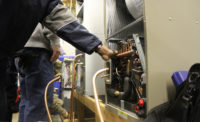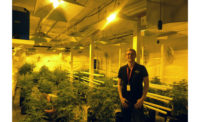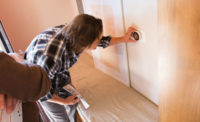As many contractors attest, a supply air plenum is a sheet metal box attached to a furnace or air handler’s outlet and is used as a central manifold connector for other ductwork. As the air blows from the furnace or air handler, it flows through the supply plenum and any ductwork attached to it. The goal of such a measurement is to get an accurate reading of the air temperature leaving the HVAC equipment.
Measuring supply plenum temperature is a process that can become second nature to experienced HVAC contractors, but, for those first attempting or learning the trade, the action offers many pratfalls and potential obstacles.
Finding a Test Location
The first step is to find an acceptable test location to obtain the measurement. This location should ideally be where any radiant effects from a coil, a heat exchanger, or heat strips cannot affect the thermometer probe. If radiant effects do affect the reading, the measurements will be unreliable and suspect, at best. Should the airflow leaving the equipment be especially blustery, multiple readings may need to be taken.
“One of the most common mistakes is choosing a poor location to measure temperature,” said David Richardson, curriculum developer and trainer, National Comfort Institute (NCI). “Anyone who’s measured temperature has chosen a poor location because it’s so easy to do, or the test conditions just don’t allow for an ideal reading to be taken.”
Steve Moon, owner, Moon Air Inc., Elkton, Maryland, said the industry commonly refers to the measurement as Delta T.
“To properly measure Delta T, you need to take the temperature reading as close to the inlet (return) and outlet (supply duct) as possible. Subtract the inlet temperature from the outlet temperature and that is your Delta T. Different types of equipment will have different Delta T calculations.”
Installing a Test Port
The second step for measuring supply plenum temperature is to install a test port in the location you feel will give the most accurate results. Richardson stressed this can largely be a guess. “Don’t beat yourself up too badly if you get the test port location wrong at first,” he said.
To install a test port, drill a hole in the supply plenum or takeoff where your measurement will be taken. In many cases, the thermometer probe can be placed in through a duct leak, if one is present, to obtain the temperature reading. A 3/8-inch drill bit with a sheath on it will prevent a technician from accidentally hitting anything hidden inside the duct system.
“Put very simply, we just drill a hole either with a 3/8-inch drill bit or a step bit about two-thirds of the way up from the bottom of the plenum, then use either a probe or K-type thermocouple to take the measurement,” said Randy Burden, service manager, Bud Anderson Heating and Cooling, Lowell, Arkansas. “The hole is then covered up with metal tape and re-used on future visits.”
Finding the proper location is key, said Richardson.
“If you measure temperature in a location where there is poor air mixing, you might find yourself reading temperatures that are extremely high or low, depending on the location where the temperature is measured,” said Richardson. “A common spot to find this is on systems that have very short plenums and fittings. The air never has a chance to mix properly coming out of the equipment and can lead to all kinds of comfort issues. If you’ve ever seen a gas heating system in heating mode with air that was 20°F warmer in one trunk than another, you’ve encountered this problem.”
Taking the Measurement
The third step is to actually take the supply temperature measurement. The thermometer used to take this measurement is of utmost importance. A digital thermometer that can display a reading to one-tenth of a degree is best.
“The old school analog thermometers won’t cut it for real temperature measurements,” said Richardson. “Allow the probe to properly read the measurement and then record it in an acceptable report form so you and those in your office can refer back to it if the need arises.”
Even with these relatively straightforward steps to measuring supply plenum temperature, Richardson said there are misconceptions that persist.
“A common misconception we see is that the temperature at the equipment is assumed to be the same as the system temperature,” said Richardson. “The eyes of many professionals have been opened when they go one step further and start to measure the impacts of the duct system. This includes looking at temperature as it comes out of the supply registers and goes back through the return grilles. Our goal at NCI is to help companies look beyond the equipment and at the entire system as a whole.”
Moon said technicians often forget to measure the difference between the outlet of the furnace (the supply duct) and the end of the trunk duct or outlet where the air exits the system (the register).
“A significant temperature difference at this point means there are ductwork issues. If insulation is poor, a lot of heat is lost here. The same thing goes with the return duct leaking. Badly insulated ducts will show significant performance issues.”
Still, Richardson said the most common mistake he and those at NCI see is the temperature reading not being recorded at all, and, even if it is, the real diagnostic value is often missed.
Publication date: 3/30/2015
Want more HVAC industry news and information? Join The NEWS on Facebook, Twitter, and LinkedIn today!









Report Abusive Comment